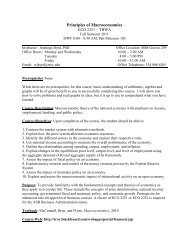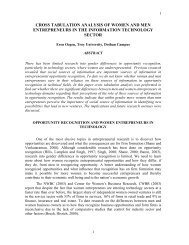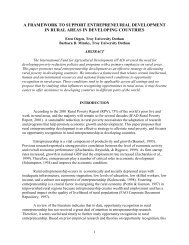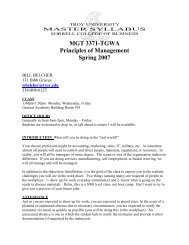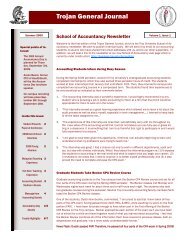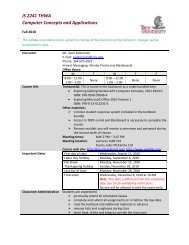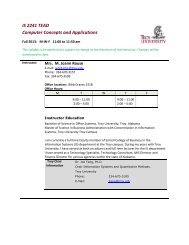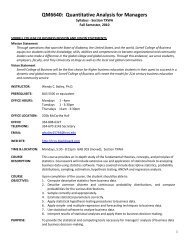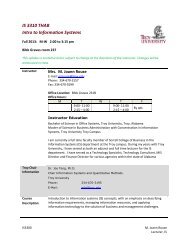investments fin 4432 · f all semester 2012 · s - the Sorrell College of ...
investments fin 4432 · f all semester 2012 · s - the Sorrell College of ...
investments fin 4432 · f all semester 2012 · s - the Sorrell College of ...
You also want an ePaper? Increase the reach of your titles
YUMPU automatically turns print PDFs into web optimized ePapers that Google loves.
PROFESSOR<br />
INVESTMENTS<br />
TROY UNIVERSITY<br />
FIN <strong>4432</strong> <strong>·</strong> FALL SEMESTER <strong>2012</strong> <strong>·</strong> SECTION 01<br />
Dr. Charod D. Dodd<br />
OFFICE 108-C Bibb Graves H<strong>all</strong>, Troy, Alabama 36082<br />
OFFICE PHONE<br />
OFFICE HOURS<br />
E-MAIL<br />
334.808.6482 (Office) and 334.670.3599 (Fax)<br />
Tuesday & Thursday 8:00 – 10:00 AM / 1:00 – 2:30 PM / 4:00 - 5:30 or by Appointment<br />
cddodd@troy.edu<br />
CLASSROOM Bibb Graves H<strong>all</strong> 147<br />
CLASS TIME TTH 11:30 AM – 12:45 PM, August 16, <strong>2012</strong> – December 4, <strong>2012</strong><br />
TEXTBOOK<br />
PREREQUISITES<br />
OFFICIAL<br />
DESCRIPTION<br />
OBJECTIVE<br />
REQUIRED<br />
RESOURCES<br />
L. Gitman, M. Joehnk, and S. Smart, Fundamentals <strong>of</strong> Investing, 11 th Edition, Pearson Prentice<br />
H<strong>all</strong>, Boston, MA, 2011. ISBN: 978-0-13-611704-9.<br />
Managerial Finance 3332 – Strictly Enforced<br />
Three hours lecture. This course studies <strong>the</strong> concepts, institutions, and processes that are<br />
employed in <strong>the</strong> management <strong>of</strong> <strong>fin</strong>ancial <strong>investments</strong>. Financial analysis <strong>of</strong> <strong>investments</strong><br />
includes markets and instruments with an emphasis on security analysis, portfolio analysis, and<br />
<strong>fin</strong>ancial planning. Focus is directed toward <strong>the</strong> quantitative methods used in <strong>the</strong> analysis <strong>of</strong><br />
investment instruments.<br />
This objective <strong>of</strong> this course is to develop within students <strong>the</strong> knowledge needed to: 1) interpret<br />
<strong>the</strong> activity in <strong>the</strong> <strong>fin</strong>ancial markets as discussed by <strong>the</strong> media and by business associates. 2)<br />
make informed and responsible decisions about <strong>the</strong> investment choices commonly encountered<br />
in <strong>the</strong> contemporary environment. Upon completion <strong>of</strong> <strong>the</strong> course <strong>the</strong> students should:<br />
- Measure and analyze <strong>the</strong> relationship between risk and return.<br />
- Compute and discuss <strong>the</strong> risk and return concepts from <strong>the</strong> perspective <strong>of</strong> an individual<br />
asset and a portfolio.<br />
- Analyze portfolios using several multifactor models.<br />
- Apply <strong>the</strong>ories <strong>of</strong> valuation and relative-valuation techniques, including <strong>the</strong> mechanics <strong>of</strong><br />
fundamental and technical analysis.<br />
- Analyze a market, industry, and company using basic industry and economic-analysis<br />
(forecasting) techniques.<br />
- Explain and value bonds, including portfolios, and duration.<br />
- Evaluate portfolio performance using <strong>the</strong> Treynor, Jensen, and Sharpe performance<br />
measures.<br />
- Discuss option trading strategies and <strong>the</strong> Black-Scholes option pricing model.<br />
- Discuss <strong>the</strong> invest merits <strong>of</strong> derivatives.<br />
- Be familiar with different investment securities.<br />
- Know <strong>the</strong> types <strong>of</strong> stock market transactions available to individual investors.<br />
- Be familiar with <strong>the</strong> tenants <strong>of</strong> <strong>the</strong> efficient market hypo<strong>the</strong>sis.<br />
- Understand <strong>the</strong> purpose and benefits <strong>of</strong> investment companies.<br />
- Understand <strong>the</strong> advantages and disadvantages <strong>of</strong> international investing.<br />
- Be able to develop a list <strong>of</strong> do and don'ts to assist in developing an investment strategy.<br />
A Texas Instruments BA II Plus or a Texas Instruments BA II Plus Pr<strong>of</strong>essional <strong>fin</strong>ancial<br />
calculator is required and will be used throughout <strong>the</strong> class. Students may not share calculators<br />
with o<strong>the</strong>rs. Students must also have access to a computer with an internet connection and a<br />
certified copy <strong>of</strong> Micros<strong>of</strong>t Excel with <strong>all</strong> Financial Add-Ins activated.<br />
Students will be encouraged and required to read and bring a copy <strong>of</strong> <strong>the</strong> W<strong>all</strong> Street Journal,<br />
New York Times, Business Weekly, Forbes, Economist, or Barron’s to each class meeting. The<br />
<strong>Sorrell</strong> <strong>College</strong> <strong>of</strong> Business participates in <strong>the</strong> Academic Partnership Program, and students may<br />
pick up a copy <strong>of</strong> <strong>the</strong> New York Times at locations throughout Bibb Graves H<strong>all</strong> or at <strong>the</strong> campus<br />
library.
DR. CHAROD D. DODD<br />
INVESTMENTS<br />
PROFESSOR OF FINANCE FIN <strong>4432</strong> – SECTION 01<br />
SORRELL COLLEGE OF BUSINESS FALL SEMESTER <strong>2012</strong><br />
ACADEMIC<br />
INTEGRITY<br />
POLICY<br />
IMPORTANT<br />
DATES<br />
STUDENT<br />
ASSISTANCE<br />
EXAM<br />
POLICY<br />
ASSIGNMENT<br />
POLICY<br />
GRADING<br />
POLICY<br />
FINAL GRADE<br />
POLICY<br />
Academic dishonesty is not tolerated. All occurrences <strong>of</strong> academic misconduct will be addressed<br />
in accordance with guidelines and procedures outlined in <strong>the</strong> ORACLE: Student Handbook and<br />
Troy University approved Honor Code that applies to <strong>all</strong> students. The code is as follows:<br />
"As a Troy University student I will conduct myself with honor and integrity at <strong>all</strong> times. I will<br />
not lie, cheat, or steal, nor will I accept <strong>the</strong> actions <strong>of</strong> those who do."<br />
Upon accepting admission to Troy University, a student immediately assumes a commitment to<br />
uphold <strong>the</strong> Honor Code, to accept responsibility for learning, and to follow <strong>the</strong> philosophy and<br />
rules <strong>of</strong> <strong>the</strong> Honor Code. Students will be required to state <strong>the</strong>ir commitment on examinations,<br />
research papers, and o<strong>the</strong>r academic work. Ignorance <strong>of</strong> <strong>the</strong> rules does not exclude any member<br />
<strong>of</strong> <strong>the</strong> Troy University community from <strong>the</strong> requirements or <strong>the</strong> processes <strong>of</strong> <strong>the</strong> Honor Code.<br />
Plagiarism, cheating, or dishonesty will cause a student to get a course grade <strong>of</strong> “F” and may<br />
result in suspension from <strong>the</strong> university for a specific or inde<strong>fin</strong>ite period <strong>of</strong> time.<br />
Monday, August 20, <strong>2012</strong> – Last day to drop, add a class, or withdraw without <strong>fin</strong>ancial penalty.<br />
Friday, October 19, <strong>2012</strong> – Last day to drop a course or withdraw without academic penalty.<br />
Tuesday, December 11, <strong>2012</strong> – Final Exam, 147 Bibb Graves H<strong>all</strong>, 2:00 PM – 4:00 PM.<br />
Students can meet with me during scheduled <strong>of</strong>fice hours listed above or arrange an appointment<br />
via e-mail. I will gener<strong>all</strong>y respond to e-mail messages within 24 hours. Please be specific when<br />
asking questions via e-mail.<br />
There will be three exams and a cumulative <strong>fin</strong>al exam administered during <strong>the</strong> course. All<br />
exams will be held during regular class hours or exam dates noted in <strong>the</strong> class schedule. Exam<br />
dates are fixed and will not be changed unless <strong>the</strong> University is closed.<br />
Each student is expected to adjust his or her schedule to fit <strong>the</strong>se exam times. A missed exam<br />
will result in a zero for <strong>the</strong> exam unless <strong>the</strong> student presents a legitimate, university approved<br />
excuse at least 24 hours prior to <strong>the</strong> scheduled exam. If <strong>the</strong> excuse is verifiable and f<strong>all</strong>s under<br />
<strong>the</strong> university’s policy, <strong>the</strong> cumulative <strong>fin</strong>al exam will substitute for <strong>the</strong> missed exam.<br />
Homework assignments, quizzes, discussion, and an Investment Project will be administered<br />
during <strong>the</strong> <strong>semester</strong>. Assignment may require that <strong>the</strong> student read <strong>the</strong> textbook in advance to <strong>the</strong><br />
material being covered in class. Moreover, each assignment may cover textbook material which<br />
will not be presented in class. Each assignment will be graded for accuracy. Additional details<br />
will be provided on <strong>the</strong> first day <strong>of</strong> class.<br />
There are 600 total points in <strong>the</strong> course. Four exams account for 100 points each. Quizzes <strong>all</strong>ow<br />
for 105 points, discussion topics <strong>all</strong>ow for 40, and <strong>the</strong> Investment Project <strong>all</strong>ows for 55 points.<br />
Letter grades are assigned by <strong>the</strong> total points earned, not percentages: 540+ is an A, 480–539 is a<br />
B, 420–479 is a C, 360–419 is a D, and below 359 is an F.<br />
Please note that <strong>all</strong> <strong>fin</strong>al grades are calculated on a cumulative point system, not a percentage<br />
system. That is, <strong>the</strong>re are 600 available points in <strong>the</strong> course. If a student has accumulated a total<br />
<strong>of</strong> 539 points (89.83 percent) at <strong>the</strong> end <strong>of</strong> <strong>the</strong> course, <strong>the</strong> <strong>fin</strong>al grade will be recorded as a B.<br />
Unless <strong>the</strong>re is an error in your <strong>fin</strong>al grade calculation, do not contact me after <strong>the</strong> <strong>fin</strong>al exam to<br />
request that your letter grade be changed. I will not give an extra assignment or change grades<br />
for any reason except in cases where <strong>the</strong>re is an error in <strong>the</strong> calculation <strong>of</strong> <strong>the</strong> <strong>fin</strong>al grade. No<br />
exceptions. Students who ignore this policy will forfeit one letter grade.<br />
PAGE 2 OF 10
DR. CHAROD D. DODD<br />
INVESTMENTS<br />
PROFESSOR OF FINANCE FIN <strong>4432</strong> – SECTION 01<br />
SORRELL COLLEGE OF BUSINESS FALL SEMESTER <strong>2012</strong><br />
ADDITIONAL<br />
REQUIREMENTS<br />
AND POLICIES<br />
CELL PHONE<br />
POLICY<br />
ADA<br />
POLICY<br />
DISCLAIMER<br />
A business-like demeanor is expected <strong>of</strong> <strong>all</strong> students in <strong>all</strong> aspects <strong>of</strong> <strong>the</strong> course, e.g., attendance,<br />
tardiness, preparation, class discussion, assignments, examinations.<br />
Students are not permitted to use a recording device (audio or video) in class.<br />
Students may not wear headgear <strong>of</strong> any kind during an exam. Students who must wear headgear<br />
for medical reasons are exempt from this policy upon written documentation <strong>of</strong> medical<br />
necessity from a qualified medical physician.<br />
Students who miss a class, for whatever reason, should obtain <strong>all</strong> notes and assignments from a<br />
fellow classmate. I do not give out my lecture notes to anyone for any reason. In addition, I do<br />
not support cramming, thus I will not answer questions about homework on <strong>the</strong> day it is due. I<br />
also require evidence <strong>of</strong> your work on an assignment before providing direction or advice.<br />
Unless you have prior approval for a specific class day, please turn <strong>of</strong>f <strong>all</strong> cell phones when you<br />
enter <strong>the</strong> classroom. Violations <strong>of</strong> this policy will not be tolerated. If a student’s cell phone rings<br />
during a lecture he or she will be excused from class for <strong>the</strong> remainder <strong>of</strong> <strong>the</strong> class day.<br />
Cell phones and Bluetooth devices should not be visible during an exam. If <strong>the</strong> instructor sees or<br />
hears a student’s cell phone during an exam <strong>the</strong> student will be excused from <strong>the</strong> exam with a zero.<br />
Students who have special needs as addressed by <strong>the</strong> Americans with Disabilities Act should<br />
speak with <strong>the</strong> instructor, contact <strong>the</strong> Office <strong>of</strong> Adaptive Needs Program (Wright H<strong>all</strong> 226), or<br />
c<strong>all</strong> 334.670.3220/3221. Various accommodations are available through <strong>the</strong> Adaptive Needs<br />
Program.<br />
The faculty in <strong>the</strong> School <strong>of</strong> Business makes every effort to accommodate unique and special<br />
needs <strong>of</strong> students with respect to speech, hearing, vision, seating, or o<strong>the</strong>r possible disabling<br />
conditions. Please notify <strong>the</strong> instructor as soon as possible <strong>of</strong> requested accommodations or<br />
ways to help.<br />
The instructor reserves <strong>the</strong> right to modify this syllabus as necessary.<br />
PAGE 3 OF 10
DR. CHAROD D. DODD<br />
INVESTMENTS<br />
PROFESSOR OF FINANCE FIN <strong>4432</strong> – SECTION 01<br />
SORRELL COLLEGE OF BUSINESS FALL SEMESTER <strong>2012</strong><br />
MODULE 1: PREPARING TO INVEST & IMPORTANT CONCEPTUAL TOOLS<br />
Thursday August 16 Introduction Course Introduction<br />
Tuesday August 21 Chapter 1 The Investment Environment I<br />
Thursday August 23 Chapter 1 The Investment Environment II<br />
Tuesday August 28 Chapter 2 Securities Markets and Transactions I<br />
Thursday August 30 Chapter 2 Securities Markets and Transactions II<br />
Tuesday September 4 Chapter 3 Investment Information and Securities Transactions I<br />
Thursday September 6 Chapter 3 Investment Information and Securities Transactions II<br />
Tuesday September 11 Chapter 4 Return and Risk I<br />
Thursday September 13 Chapter 4 Return and Risk II<br />
Tuesday September 18 Chapter 5 Modern Portfolio Concepts I<br />
Thursday September 20 Chapter 5 Modern Portfolio Concepts II<br />
Tuesday September 25 Exam I Exam I: 11:30 AM – 12:45 PM<br />
MODULE 2: INVESTING IN COMMON STOCK & INVESTING IN FIXED-INCOME SECURITIES<br />
Thursday September 27 Chapter 6 Common Stocks I<br />
Tuesday October 2 Chapter 6 Common Stocks II<br />
Thursday October 4 Chapter 7 Analyzing Common Stocks I<br />
Tuesday October 9 Chapter 7 Analyzing Common Stocks II<br />
Thursday October 11 Chapter 8 Stock Valuation I<br />
Tuesday October 16 Chapter 8 Stock Valuation II<br />
Thursday October 18 Group Project Group Project Work Day<br />
Tuesday October 23 Chapter 10 Fixed-Income Securities I & II<br />
Thursday October 25 Chapter 11 Bond Valuation I<br />
Tuesday October 30 Chapter 11 Bond Valuation II<br />
Thursday November 1 Exam II Exam II: 11:30 AM – 12:45 PM<br />
MODULE 3: PORTFOLIO MANAGEMENT & DERIVATIVE SECURITIES<br />
Tuesday November 6 Chapter 12 Mutual Funds: Pr<strong>of</strong>ession<strong>all</strong>y Managed Portfolios<br />
Thursday November 8 Chapter 13 Managing Your Own Portfolio<br />
Tuesday<br />
Thursday<br />
November 13<br />
November 15<br />
Chapter 14<br />
Chapter 14<br />
Tuesday November 20 Troy Campus F<strong>all</strong> Break<br />
Thursday<br />
Tuesday<br />
November 22<br />
November 27<br />
Holiday<br />
Project<br />
Options: Puts and C<strong>all</strong>s I<br />
Options: Puts and C<strong>all</strong>s II<br />
Thanksgiving<br />
Project Deadline<br />
Tuesday November 27 Chapter 15 Commodities and Financial Futures<br />
Thursday November 29 Exam III Exam III: 11:30 AM – 12:45 PM<br />
MODULE 4: COMPREHENSIVE FINAL EXAM<br />
Tuesday December 4 Review Final Exam Review<br />
Tuesday December 11 Exam IV Comprehensive Exam IV: 2:00 PM – 4:00 PM<br />
END OF COURSE<br />
PAGE 4 OF 10
DR. CHAROD D. DODD<br />
INVESTMENTS<br />
PROFESSOR OF FINANCE FIN <strong>4432</strong> – SECTION 01<br />
SORRELL COLLEGE OF BUSINESS FALL SEMESTER <strong>2012</strong><br />
THIS PAGE WAS INTENTIONALLY LEFT BLANK<br />
PAGE 5 OF 10
DR. CHAROD D. DODD<br />
INVESTMENTS<br />
PROFESSOR OF FINANCE FIN <strong>4432</strong> – SECTION 01<br />
SORRELL COLLEGE OF BUSINESS FALL SEMESTER <strong>2012</strong><br />
PROJECT<br />
OVERVIEW<br />
ADDITIONAL<br />
POLICIES<br />
DEADLINES<br />
COMPENSATION<br />
SCHEME<br />
INVESTMENT CONSULTING PROJECT<br />
TROY UNIVERSITY<br />
REAL ESTATE <strong>4432</strong> – FALL SEMESTER <strong>2012</strong> – SECTION 01<br />
Congratulations, you have just completed your degree at Troy University and you have accepted a<br />
position as a research analyst in <strong>the</strong> equities division <strong>of</strong> Dodd Financial, a regional <strong>fin</strong>ancial<br />
services firm providing <strong>fin</strong>ancial consulting services to investors in <strong>the</strong> sou<strong>the</strong>astern United States.<br />
A national equities investment company recently approached Dodd Financial seeking to make a<br />
sizeable investment in Alabama. While our client is a major equities and fixed income securities<br />
investor for pension funds, your analysis should be based on <strong>the</strong> attractiveness <strong>of</strong> <strong>the</strong> stock as a<br />
stand-alone asset. That is, ignore any portfolio or corporate objective issues. The client faces a<br />
28% marginal tax rate, prefers more wealth to less, is risk averse, and has no passive income.<br />
As research analysts in <strong>the</strong> equities division you will identify three suitable stocks. Each student<br />
sh<strong>all</strong> select a stock according to <strong>the</strong> first letter <strong>of</strong> <strong>the</strong>ir last name. You will <strong>the</strong>n conduct a detailed<br />
analysis <strong>of</strong> <strong>the</strong> stock and make a recommendation to our client in <strong>the</strong> form <strong>of</strong> a written, formal<br />
report. The ultimate question to be answered by your analysis is as follows: Under <strong>the</strong> current<br />
market conditions we strongly recommend our client to purchase <strong>the</strong> securities?<br />
The essay part <strong>of</strong> <strong>the</strong> project must be typed and double-spaced using word processor (Micros<strong>of</strong>t<br />
Word or Pages) and consists <strong>of</strong> <strong>the</strong> name <strong>of</strong> <strong>the</strong> stock, <strong>the</strong> ticker symbol, industry, and <strong>the</strong> stock<br />
market where <strong>the</strong> stock is traded. The following four sections should make up <strong>the</strong> body <strong>of</strong> <strong>the</strong><br />
report: SECTION IV: An Overview, SECTION V: Competition, SECTION VI: Financial<br />
Characteristics and Pr<strong>of</strong>itability, SECTION VII: Future Prospect<br />
The results <strong>of</strong> your analysis must be presented in a formal feasibility report using <strong>the</strong> outline<br />
provided on <strong>the</strong> following page. Analysts are expected to make full use <strong>of</strong> <strong>the</strong> tools and techniques<br />
discussed in typical Finance principles and Investments courses, as well as your own creative and<br />
analytical abilities.<br />
Each research analyst is expected to make this a pr<strong>of</strong>essional document <strong>of</strong> <strong>the</strong> highest standard,<br />
and plagiarism will result in dismissal from <strong>the</strong> firm. Using double-spaced typed pages, figures,<br />
and tables, please contain your remarks to 5–10 pages exclusive <strong>of</strong> <strong>the</strong> cover page, table <strong>of</strong><br />
contents, and executive summary.<br />
Remember that <strong>the</strong> company places a priority on accuracy <strong>of</strong> your analysis but we also reward<br />
creativity, pr<strong>of</strong>essionalism, and insightful analysis. The compensation you receive will be<br />
determined by how well you meet <strong>the</strong>se expectations. A copy <strong>of</strong> your report will be provided to <strong>the</strong><br />
listing agent and owners <strong>of</strong> <strong>the</strong> property you evaluate. You may legitimately access any<br />
pr<strong>of</strong>essional sources willing to assist you.<br />
Hastily-prepared reports, plagiarized reports, reports with excessive grammatical errors, and<br />
reports without <strong>all</strong> <strong>of</strong> <strong>the</strong> required components will not be accepted.<br />
Final drafts <strong>of</strong> <strong>the</strong> reports are due on Tuesday, November 27, <strong>2012</strong> by 11:30 AM. Submit a printed<br />
and bound copy <strong>of</strong> your <strong>fin</strong>al report in a sealed envelope addressed to Dr. Dodd using <strong>the</strong> contact<br />
information at <strong>the</strong> top <strong>of</strong> this syllabus.<br />
Creativity and Pr<strong>of</strong>essionalism:<br />
Content Accuracy:<br />
Analysis and Application:<br />
Total Points Available:<br />
15 Points<br />
15 Points<br />
25 Points<br />
55 Points<br />
PAGE 6 OF 10
DR. CHAROD D. DODD<br />
INVESTMENTS<br />
PROFESSOR OF FINANCE FIN <strong>4432</strong> – SECTION 01<br />
SORRELL COLLEGE OF BUSINESS FALL SEMESTER <strong>2012</strong><br />
All investment research reports for Dodd Financial contain <strong>the</strong> following sections:<br />
I. Cover Page<br />
II. Table <strong>of</strong> Contents for All Report Sections, Tables, and Figures, References<br />
III. Executive Summary <strong>of</strong> Important Facts and Conclusions<br />
IV.<br />
Brief history<br />
V. Analysis<br />
1. Economic Analysis<br />
The economic analysis is <strong>the</strong> first step in <strong>the</strong> traditional analysis.<br />
The following economic factor effects on each stock chosen, should be discussed<br />
here:<br />
Business cycle<br />
GDP<br />
Industrial production<br />
Over<strong>all</strong> Savings Vs. Consumption<br />
Taxes<br />
Government Spending<br />
Debt Management<br />
Money Supply<br />
Interest Rates<br />
Inflation<br />
Consumer Spending<br />
Business Investments<br />
Foreign Trade and Foreign Exchange rates<br />
Refer to textbook pages 250 – 254.<br />
PAGE 7 OF 10
DR. CHAROD D. DODD<br />
INVESTMENTS<br />
PROFESSOR OF FINANCE FIN <strong>4432</strong> – SECTION 01<br />
SORRELL COLLEGE OF BUSINESS FALL SEMESTER <strong>2012</strong><br />
2. Industry Analysis<br />
The first step in <strong>the</strong> industry analysis is to establish <strong>the</strong> competitive position <strong>of</strong> a particular<br />
industry in relation to o<strong>the</strong>rs. Then, identify companies within <strong>the</strong> industry that hold<br />
particular promise.<br />
The following are discussion question that you would want to discuss in this section:<br />
a. Financial makeup, basic characteristics, <strong>fin</strong>ancial ratios about performance<br />
<strong>of</strong> <strong>the</strong> company as compared to <strong>the</strong> industry<br />
b. What is <strong>the</strong> nature <strong>of</strong> <strong>the</strong> industry? Is it monopolistic, or are <strong>the</strong>re many<br />
competitors? Do a few set <strong>the</strong> trend for <strong>the</strong> rest, and if so, who are those<br />
few?<br />
c. To what extent is <strong>the</strong> industry regulated? If so, how “friendly” are <strong>the</strong><br />
regulatory bodies?<br />
d. What role does labor play in <strong>the</strong> industry? How important are labor<br />
unions? Are <strong>the</strong>re good labor relations within <strong>the</strong> industry? When is <strong>the</strong><br />
next round <strong>of</strong> contract talks?<br />
e. How important are technological developments? Are any new<br />
developments taking place? What impact are potential breakthroughs<br />
likely to have?<br />
f. Which economic forces are especi<strong>all</strong>y important to <strong>the</strong> industry? Is<br />
demand for <strong>the</strong> industry’s goods and services related to key economic<br />
variables? If so, what is <strong>the</strong> outlook for those variables? How important<br />
is foreign competition to <strong>the</strong> health <strong>of</strong> <strong>the</strong> industry?<br />
g. What are <strong>the</strong> important <strong>fin</strong>ancial and operating considerations? Is <strong>the</strong>re an<br />
adequate supply <strong>of</strong> labor, material, and capital? What are <strong>the</strong> capital<br />
spending plans and needs <strong>of</strong> <strong>the</strong> industry?<br />
Refer to textbook pages 254-258.<br />
PAGE 8 OF 10
DR. CHAROD D. DODD<br />
INVESTMENTS<br />
PROFESSOR OF FINANCE FIN <strong>4432</strong> – SECTION 01<br />
SORRELL COLLEGE OF BUSINESS FALL SEMESTER <strong>2012</strong><br />
3. Fundamental Analysis<br />
Fundamental analysis is <strong>the</strong> study <strong>of</strong> <strong>the</strong> <strong>fin</strong>ancial affairs <strong>of</strong> a business for <strong>the</strong> purpose <strong>of</strong><br />
better understanding <strong>the</strong> company that issued <strong>the</strong> common stock. In <strong>the</strong> fundamental analysis<br />
<strong>the</strong> value <strong>of</strong> <strong>the</strong> stock is influenced by <strong>the</strong> performance <strong>of</strong> <strong>the</strong> company that issued <strong>the</strong> stock.<br />
The following should be discussed in this section:<br />
a. <strong>the</strong> competitive position <strong>of</strong> <strong>the</strong> company.<br />
b. Its composition and growth in sales.<br />
c. Pr<strong>of</strong>it margins and <strong>the</strong> dynamics <strong>of</strong> company earnings.<br />
d. The composition and liquidity <strong>of</strong> corporate resources (<strong>the</strong> company’s asset<br />
mix).<br />
e. The capital structure <strong>of</strong> <strong>the</strong> company.<br />
f. Financial statements<br />
g. Financial ratios<br />
a. Liquidity Measures<br />
b. Activity Measures<br />
c. Leverage Measures<br />
d. Pr<strong>of</strong>itability Measures<br />
e. Common Stock Measures<br />
Refer to textbook pages 258-276<br />
Recommendation<br />
VI.<br />
VII.<br />
VIII.<br />
Future Prospect<br />
Discussion <strong>of</strong> new goods, services or products, managements direction, and your pr<strong>of</strong>essional opinion about <strong>the</strong><br />
growth or lack <strong>the</strong>re <strong>of</strong> in <strong>the</strong> firm. Discuss a forecast <strong>of</strong> future cash flows, EPS, dividends, and stock price.<br />
Discuss any international opportunities for growth.<br />
Summary <strong>of</strong> Conclusions and Final Recommendation<br />
References<br />
PAGE 9 OF 10
DR. CHAROD D. DODD<br />
INVESTMENTS<br />
PROFESSOR OF FINANCE FIN <strong>4432</strong> – SECTION 01<br />
SORRELL COLLEGE OF BUSINESS FALL SEMESTER <strong>2012</strong><br />
THIS PAGE WAS INTENTIONALLY LEFT BLANK<br />
PAGE 10 OF 10



